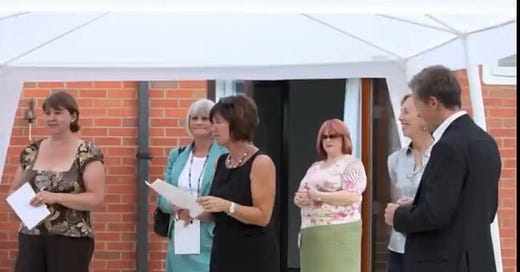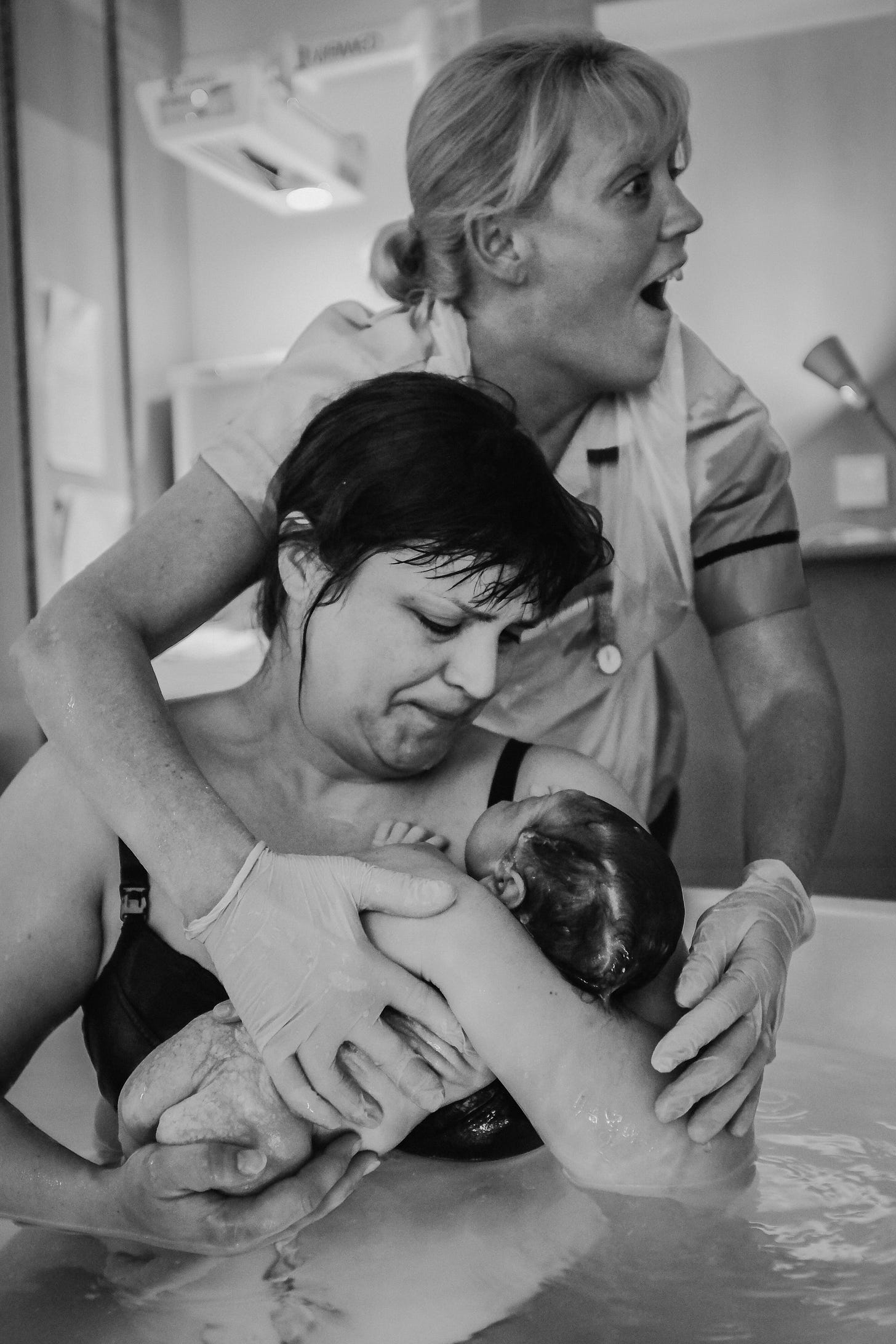This photo was 15 years ago, at the opening a wonderful free-standing birth centre in Blackburn, Lancashire.
To say that the realisation of this happening was a dream that felt unbelievable at times is an understatement. The decision for the new birth place in our locality wasn’t mine, but I was tasked with making it happen - alongside others. I was the head of midwifery and part of my job was to ‘convince’ stakeholders that having birth centres (known as midwifery-led units) was a good idea. The development was part of a bigger reconfiguration of acute hospital services (Blackburn and Burnley) which included the amalgamation of two maternity services into one. One large obstetric-led department in Burnley for high-risk care, and three midwifery-led units (birth centres). One ‘alongside’ which is next to the labour ward and two freestanding facilities (away from hospital services). Blackburn Birth Centre was to be the larger one with staff serving the birthing population 24 hours a day. A community continuity model of care was proposed and with continual adaptation it gained momentum and was successful. The third much smaller facility was in Rossendale, and was staffed by community midwives only when someone went into labour. Sadly the facility is no longer in use.
I was enthusiastic helping to lead the creation of these birth spaces as my experience as a clinical midwife included nine years in a GP unit - a kind of birth centre. Working there changed me almost at a genetic level - I wouldn’t be writing this post if I hadn’t had the exposure to what birth could and can look like. That’s another story, detailed in my first memoir Catching Babies.
Fast forward to 2010 and standing up in front of angry midwives (they didn’t want changes especially the amalgamation of two sites), worried medical teams (mainly neonatologists) and communities who didn’t know what they didn’t know. Most families had no knowledge of birth centres, and what birth there could be like. In 2010 there was no formal quantitative evidence to say that birth in a midwifery-led and free-standing facility was safe or advantageous. My ‘presentations’ were mainly centred on mine and others’ anecdotal experience, and qualitative research evidence of women’s stories and increased job satisfaction for midwives. It was a tough call. With firmly folded arms midwives spoke of their disappointment in me for allowing the changes to happen.
The birthing facility in Blackburn, against all odds, and with exceptional clinical leadership and drive, became hugely successful - women and families loved it. For more than a decade Blackburn Birth Centre (BBC) was a valid and desired choice for families in East Lancashire and beyond. It quickly put East Lancashire Hospitals Trust on the map for being a maternity service of excellence, providing the full choice option for place of birth. Over the years I’ve felt proud taking midwives from many other countries to visit the venue, a beautiful home-from-home environment where midwives practice midwifery and support staff love helping them.
The purposefully designed rooms are perfect and women and families can use the gardens when weather permits. I remember when my colleague Vanessa, then the commissioner for women and children’s services, found the disused one-story building and she stayed up all night to bid for funding to buy the premises. It was touch and go. The small but meaningful celebration when Vanessa got news that funding had been granted is still clear in my mind. What a scoop, everything was falling into place.
And now, in 2025, post COVID (had an impact due to changes in availability), there is a decline in numbers of people choosing BBC for birth. The reasons are many and include, I am informed, the centre being frequently on ‘divert’ due to staffing which has a huge impact on bookings. Women don’t want to risk choosing Blackburn just in case it’s not staffed when they go into labour. Midwives tell me they feel demoralised knowing this, yet understanding the difference birthing in the facility can make to those with straightforward pregnancies. We are worried about the future of Blackburn Birth Centre.
Should there be a choice?
Evidence from a range of high-quality studies highlights that, for women with low-risk pregnancies, planned births at home or in midwifery-led settings are both clinically safe and economically advantageous when compared to planned hospital births. These studies found that birth centre settings are associated with significantly lower rates of medical intervention and comparable perinatal outcomes. And satisfaction rates are high.
Given the unprecedented rise in induction of labour and caesarean birth rates with no improvement in outcomes for mother or baby, and the increased reporting of birth trauma - midwifery-led settings need to be supported and protected.
When I received a message from one of the midwives asking for help it was a call to action. The staff want to see the facility used again to its full potential, for women to experience undisturbed birth if this is their choice. After all, currently, in England, if a woman chooses to have a Caesarian birth she is more often than not granted her wish. But if a person desires a normal, physiological birth, according to the statistics, she is less likely to succeed.
And then there’s the midwives. We’re witnessing a mass exodus from the profession, many reporting their dissatisfaction of not being able to practise ‘midwifery’. Experienced midwives are nearing retirement and many newer members have never seen childbirth without intervention. CS rates in some hospitals in England are over 60% on monthly reports, and in one maternity service in Ireland the rate for first time mothers was 73% in February. 78 mothers cage birth that month. How can this be?
This photo below is one of our favourites and tells a story. Look closely. The mother, Vic, has just given birth to Olivia at Blackburn Birth Centre. Vic is a family friend. What strikes us is the joy in her face, and in that of Michelle, the midwife’s face. Maybe Michelle was one of those midwives with folded arms…I’m not sure.
My final thoughts…
We have a national crisis. Some call it a perfect storm. If midwifery-led services are scaled back, more women will be referred to obstetric-led units unnecessarily. This increases demand on already stretched hospital services and can add to the already over-medicalisation of birth.
As highlighted previously, midwifery-led birth environments are generally more cost-effective. Reducing these services can lead to higher intervention rates and longer hospital stays, driving up healthcare costs.
De-prioritising midwifery-led facilities can disproportionately affect communities with limited access to healthcare or those who prefer community-based, culturally sensitive services. This can widen health inequalities.
Midwives thrive in environments where they can practice autonomously and provide relational care. Undermining midwifery-led services risks losing skilled professionals due to burnout, dissatisfaction, or feeling undervalued.
Women have the right to choose the type of care they receive. A diverse maternity system that includes robust midwifery-led options ensures this choice is meaningful.
I will do all I can to help. Watch this space.
PS If you happen to be reading this and you have given birth at Blackburn Birth Centre, please consider completing this survey. Thank you!







You are such an inspiration! Maybe we have to get to breaking point before the politicians realise the depth of the crisis!
You have always been inspirational about child birth Sheena .I was proud and empowered to share the birth of my grandaughter at the centre fourteen years ago.It was a beautiful experience .
Hope your keeping well .Anne